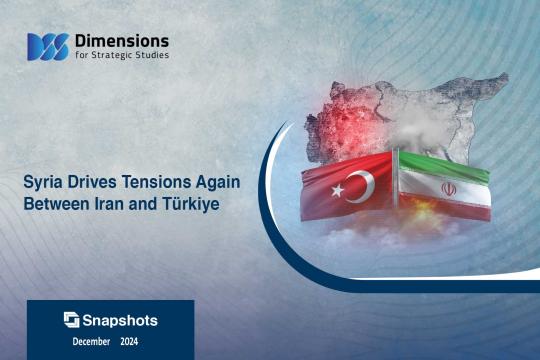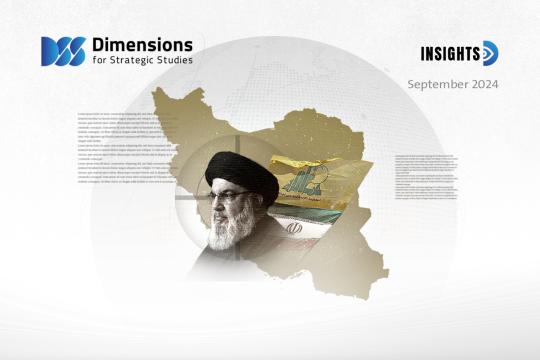
The Collapse of Iran’s Mediterranean Dream
2024-12-106531 view
Establishing a presence on the Mediterranean Sea has long been a supreme goal of Iran’s regional project. To achieve it, the Islamic Republic pressured its neighbor Iraq to build a railway that would link the port of Bandar-e Emam Khomeyni, on the Iranian side of the Persian Gulf, with the Syrian port of Latakia on the Mediterranean coast. This corridor would ultimately support commercial, economic, and security relations between Iran, Iraq, and Syria.
The fall of the Syrian regime of Bashar al-Assad has dealt a fatal blow to this project, likely ending Iran’s geopolitically vital dream of reaching the Mediterranean as the Syrian opposition takes power.
There is no doubt that major strategic considerations stood behind Iran’s ambition to reach the Mediterranean. The goal was part of Tehran’s approach to the region and the world, which aimed to link up its military presence in Iraq and Syria and use this to serve its economic interests, which aspired to reach European markets by ensuring a safe land passage, bypassing both U.S. sanctions and American assets that could block its route to the sea.
The railroad that Iran wished to build would have run from the Iraqi port of Basra on the Arabian Gulf in southern Iraq to the Albu Kamal area on the Iraqi-Syrian border, and then to Deir Ezzor, Aleppo and finally Latakia on the Mediterranean Sea. The route would have formed a one-way economic corridor from Iran to Iraq and Syria, as well as bringing millions of Shiite Iranian pilgrims every year to visit shrines, despite the security and economic burden this would place on Syria.
Tehran’s uncertainty about the future of its influence in Assad’s Syria had pushed it to find alternatives to support its regional project over the long term, the success of which depended on Iraq and Syria.
Specifically, Iran had to take into account escalating Israeli and American pressure against its land cargo operations across the Iraqi-Syrian border, including through drone attacks and sanctions on Iranian transportation companies—most notably Mahan Air, which the U.S. accused of transporting weapons and fighters into Syria in violation of international aviation laws.
Accordingly, Iran began to consider more practical solutions to these complex strategic calculations, stepping up its efforts to complete the railway connection with Iraq. However, what Iran did not anticipate was the fall of the Assad regime and the impact this would have on Tehran’s overall vision for Syria moving forward.
The fall of the Assad regime presents Iran with a complex strategic challenge: a new Syria, where Iran’s image is deeply tarnished by its role over the past decade in all-out support for Bashar al-Assad. The Syrian opposition hods Tehran directly responsible for the killing of hundreds of thousands of civilians and the destruction and depopulation of entire cities, in an organized strategy aimed at changing the country’s demographic make-up.
Iran has also plundered the resources of the Syrian state, exploiting the country’s territory for the interests of Lebanese armed movement Hezbollah and turning Syria into a regional corridor for the passage of weapons, drugs and fighters. Accordingly, it will be impossible for Iran to reinstate a presence in Syria in the form it took during the Assad era.
The fall of the Assad regime means that Iran’s dream of the Mediterranean Sea will now be very difficult to achieve, if not impossible. Furthermore, Iranian forces’ movements in southern Syria it is now completely cut off from Hezbollah. Iran’s retreat from the Iraqi-Syrian border has also completely isolated it from Hezbollah, undermining its ability to sustain a geopolitical project it has long boasted extends from Afghanistan to Beirut.
Thus, Iran now faces the geographical reality that the fall of the Assad regime, along with its allies’ losses in Gaza and Lebanon, have cost it not only its ambition if reaching the Mediterranean Sea, but also two-thirds of the geography of its long-vaunted “Axis of Resistance”. This has left Iran largely isolated from the areas of geopolitical competition that the Syrian arena had secured vis-à-vis important regional powers, notably Türkiye.
In summary, Iran’s project of reaching the Mediterranean Sea, which it viewed as the final strategic goal of its support for the Assad regime, ended before it was implemented. The fall of the regime means Iran has lost its entire investment in the country’s devastating 13-year war. After all these years, it has nothing left in Syria—except a deep sense of resentment among Syrians themselves towards the Islamic Republic and its project in the region.





